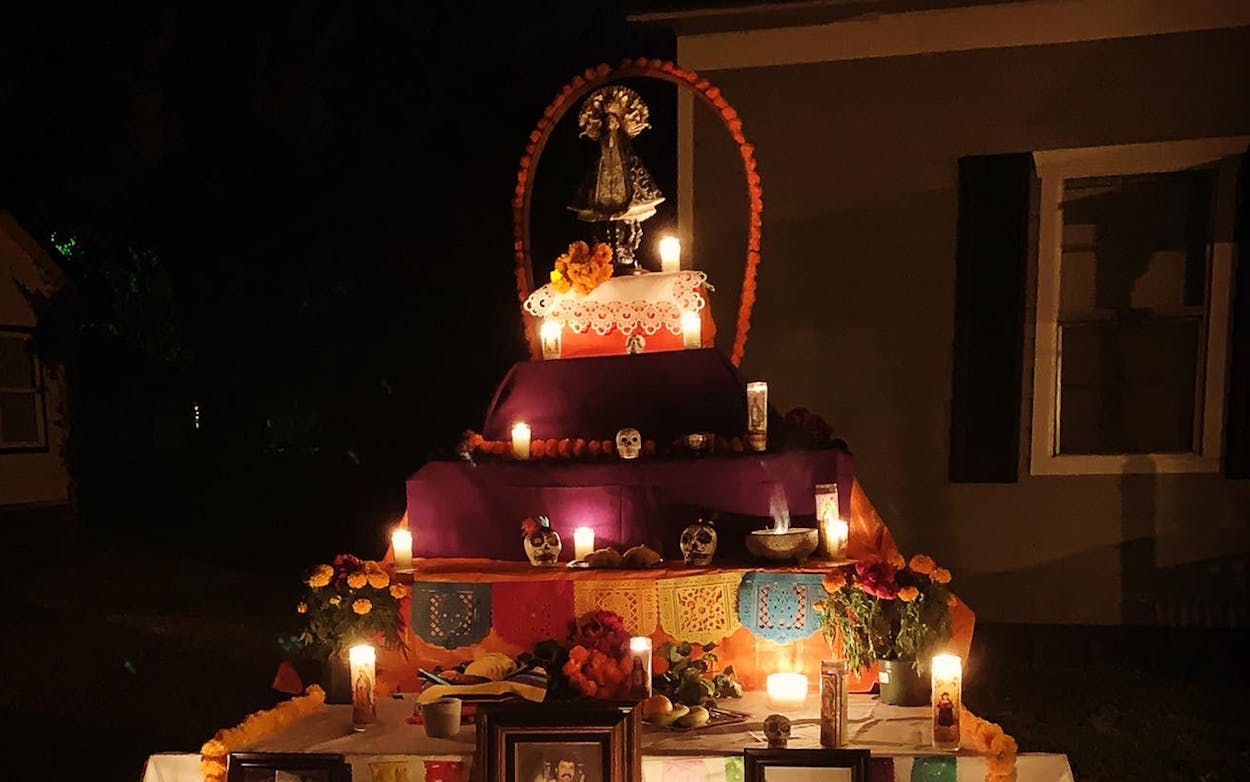For generations, Mexican households have come alive on November 2 to welcome back the spirits of loved ones who have died. Through elaborately-decorated altars, or ofrendas, families provide food and drinks for the dead, along with some of their photos and belongings, on Día de los Muertos. The Mesoamerican tradition adapted during Spanish colonization, and is now celebrated throughout North America. We asked our readers to submit stories about their altars or how they celebrate the holiday, and here’s what they said:
A Community Altar
I’ve always appreciated the vibrant colors, the candles, and the beauty of an altar. I didn’t really grow up celebrating Día de los Muertos—however, I’ve lost my father, my stepfather, and grandparents over the years. This year, I decided to put a six-foot altar in my front yard to share with my community and to celebrate my family. I’m nervous because I’m not sure how the community will react, but I’m hopeful they will embrace it. And perhaps next year, other neighbors will display altars of their own. —Jaime Ayala, Bartlett
A First-Time Ofrenda
This year was our first Mexican ofrenda for Día de los Muertos. It’s the first time in 30 years we celebrated this tradition from my grandma, Mamá Flor. She was the matriarch in our family, but died from leukemia just one year after my mom came to the U.S. She was able to get back to Mexico just in time to say goodbye. It’s the first time our first-generation Mexican-American family shared in this beautiful experience. There were tears, smiles, and big, long hugs. It felt like we had found a missing piece in our family. A big thanks to my little sister, Victoria, for getting us together and reviving this important tradition. —Leslie Rangel, Austin
“This is Beautiful, Just Like Coco”
We didn’t have altars growing up. I’m ashamed to admit that I mainly remember them as decorations at some Mexican restaurants. I was reintroduced to them at an elementary school I once worked at and my kids attended with a high Hispanic population. A beautiful, colorful altar was part of their annual observance at the school.
After the death of my beloved 13-year-old son Noah, Ms. Muñoz, a sweet teacher and friend of mine, started to include him with his picture and his favorite cookies on the altar, too. Encouraged by this, I then started to do an annual ofrenda at home for Noah. To me, it is a way to remember our loved ones and to show that even in death, they are still part of our lives, part of our celebrations.
I was a bit nervous when my young nephews and niece first saw our altar at home. But my niece, upon seeing her cousin’s altar for the first time, exclaimed: “This is beautiful, just like Coco!” Her appreciation gave me peace; Noah’s love will live on because we continue to celebrate him. —Emily R., Pflugerville
A Festival Ofrenda
I am the sponsor for Veterans Memorial High School Águilas guerreras chapter of Sociedad Honoraria Hispánica (an honor organization for high achieving students in Spanish). For the last four years, our members have contributed items for an altar that the officers construct for the Day of the Dead Festival held in downtown Corpus Christi. The altar is dedicated to the friends and family members of members of the organization and the school. I love to see my students discuss the significance of the items as they mock up the altar, before officers construct them at the Ritz Theater. I also love to hear students tell stories about their loved ones when they bring in pictures. —Nilsa Becho Sullivan, San Antonio
Rest In Pup
A year ago, our beloved 16 1/2 year old cocker spaniel passed away. I was devastated. My 12-year-old daughter, who is taking Spanish in school, made a beautiful Día de los Muertos altar to celebrate his life. —Catherine Cledelin, Austin
Memories of My Grandmother
I remember walking to the cemetery, pulling a little once-red wagon full of flowers with my grandmother. We took lunch and snacks because we spent the whole day there. Most of our community was there. Several people wandered around singing and playing a guitar. The priest came and blessed the graves and to protect us from evil spirits. We also took an item for each family member. Could be a beer, a small bank built like a pig and full of coins, sea shells—items special to them. I loved it, and feel sad that tradition has not passed on to grandchildren. —Linda Cantu
- More About:
- Mexico








